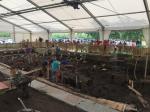Summary (English)
The campaign began with the closing of Sector 1, excavated between 2007 and 2014, with the partial backfilling of the old excavation area, undertaken with great caution in order to preserve the vertical timber posts/piles still _in __situ_ after the dendrochronology sampling.
Subsequently, after dismantling and rebuilding the covering, a new excavation area was opened (Sector 2). This corresponds with a strip of land running from the western edge of Sector 1 towards the centre of the basin, 9 m wide and 17 m long covering a total area of 153 m2. It includes all the extensions opened between 2013 and 2015. Once a grid was set up and the agricultural top soil removed, a white carbonaceous layer (US 2) sealing the underlying stratigraphy was excavated, revealing a sequence similar to that found in previous years.
The excavation of a larger area in this zone provided a more comprehensive understanding of the depositional dynamics showing the stratigraphy to be more complex. Broadly speaking, the entire deposit was affected by interaction with the thick peat layers of natural origin that closed in a wedge towards the settlement’s western edge extending in fingers into the anthropological deposits, mainly represented by dumps of mixed materials, or with the natural layers formed by the alteration of these dumps of material or with elements from collapsed walls.A large wedge-shaped structure was identified in the strip closest to the shoreline, which was revealed to be rather complex with alternating layers rich in organic materials and layers containing construction materials (baked clay, clay) and abundant ash and charcoal. Alongside these layers there was a midden containing pottery in a grey sandy-silt matrix. There were numerous vertical and horizontal timber elements present within the stratigraphy.
The final intervention of 2016 was the recovery of the long beam, the twin of the one found last year. During this operation, numerous other smaller timber elements were found, probably part of the same structure. The new beam (EL 1205) is c. 7.60 m long with a maximum width of 19-20 cm and presents 25 quadrangular holes, and is therefore of the same dimensions as the first one. The beam is now being conserved at the Centre for the Treatment of Saturated Timber.
This season’s campaign on the site of Lucone Polpenazze also recovered numerous artefacts of archaeological interest. The predominant class was pottery with numerous vessels that were intact or nearly intact, or were completely reconstructable. A number of terracotta spindle whorls and stone tools were found. Among the most interesting finds were a wooden axe handle, found a short distance from a copper axe head (RR- 2158 – US 452), and a necklace of faience, seed and tooth shell beads. Another important and rare find was a large piece of a sort of carbonised biscuit.
- Marco Baioni- Museo Archeologico della Valle Sabbia - Gavardo
Director
Team
- Claudia Mangani
- Fiorenza Gulino
- Flavio Redolfi Riva
- Michele Colosio
- Nicoletta Martinelli (Dendrodata – Verona)
- Claudia Mangani- Museo Archeologico G. Rambotti – Desenzano del Garda
- Cristiano Nicosia
- Renata Perego
- Cesare Ravazzi (CNR – IDPA – Milano)
- Angelo Lando
- Carlo Pettini (Associazione Gruppo Grotte Gavardo)
- Ezio Ferraresi
Research Body
- Museo Archeologico della Valle Sabbia - Gavardo
Funding Body
- Comune di Gavardo
- Comune di Polpenazze del Garda
- Regione Lombardia






![Download [PDF]](/excavation/skins/fasti/images/results/download_sml.png)